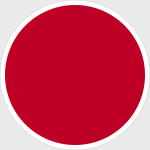Hobby Master HA8805 Imperial Japanese Navy Mitsubishi A6M2 "Zero" Fighter - V-173, Saburo Sakai, Tainan Air Group, Rabaul, June-July 1942 (1:48 Scale)
"We have resolved to endure the unendurable and suffer what is insufferable."
- Japanese Emperor Hirohito speaking to the Japanese people after the atomic bombings, August 1945
 The Mitsubishi A6M "Zero" is a long-range carrier-based fighter aircraft formerly manufactured by Mitsubishi Aircraft Company, a part of Mitsubishi Heavy Industries. It was operated by the Imperial Japanese Navy (IJN) from 1940 to 1945. The A6M was designated as the Mitsubishi Navy Type 0 carrier fighter, or the Mitsubishi A6M Rei-sen. The A6M was usually referred to by its pilots as the Reisen (zero fighter), "0" being the last digit of the imperial year 2600 (1940) when it entered service with the Imperial Navy. The official Allied reporting name was "Zeke", although the name "Zero" was used colloquially as well.
The Mitsubishi A6M "Zero" is a long-range carrier-based fighter aircraft formerly manufactured by Mitsubishi Aircraft Company, a part of Mitsubishi Heavy Industries. It was operated by the Imperial Japanese Navy (IJN) from 1940 to 1945. The A6M was designated as the Mitsubishi Navy Type 0 carrier fighter, or the Mitsubishi A6M Rei-sen. The A6M was usually referred to by its pilots as the Reisen (zero fighter), "0" being the last digit of the imperial year 2600 (1940) when it entered service with the Imperial Navy. The official Allied reporting name was "Zeke", although the name "Zero" was used colloquially as well.
The Zero is considered to have been the most capable carrier-based fighter in the world when it was introduced early in World War II, combining excellent maneuverability and very long range. The Imperial Japanese Navy Air Service also frequently used it as a land-based fighter.
In early combat operations, the Zero gained a reputation as a dogfighter, achieving an outstanding kill ratio of 12 to 1, but by mid-1942 a combination of new tactics and the introduction of better equipment enabled Allied pilots to engage the Zero on generally equal terms. By 1943, the Zero was less effective against newer Allied fighters. The Zero lacked hydraulic boosting for its ailerons and rudder, rendering it difficult to maneuver at high speeds. Lack of self-sealing fuel tanks also made it more vulnerable than its contemporaries. By 1944, with Allied fighters approaching the A6M's levels of maneuverability and consistently exceeding its firepower, armor, and speed, the A6M had largely become outdated as a fighter aircraft. However, as design delays and production difficulties hampered the introduction of newer Japanese aircraft models, the Zero continued to serve in a front-line role until the end of the war in the Pacific. During the final phases, it was also adapted for use in kamikaze operations. Japan produced more Zeros than any other model of combat aircraft during the war.
Pictured here is a 1:48 scale replica of an Imperial Japanese Navy Mitsubishi A6M2 "Zero" fighter that was piloted by Saburo Sakai, who was deployed to Rabaul, between June-July 1942.
Sold Out!
Dimensions:
Wingspan: 9-inches
Length: 7-1/4-inches
Release Date: September 2018
Historical Account: "Gekitsui-O" - Sub-Lieutenant Saburo Sakai was a Japanese naval aviator and flying ace ("Gekitsui-O") of the Imperial Japanese Navy during World War II.
Sakai had 28 aerial victories (including shared) by official Japanese records, while his autobiography "Samurai!", co-written by Martin Caidin and Fred Saito, claims 64 aerial victories. Such discrepancies are common, and pilots' official scores are often lower than those claimed by the pilots themselves, due to difficulties in providing appropriate witnesses or verifying wreckage, and variations in military reports due to loss or destruction.





 A6M2 Zero Fighter
A6M2 Zero Fighter 


